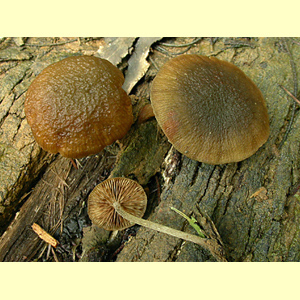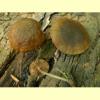
images/Simocybe/Simocybe2.jpg
Small to medium agaric, growing on the ground, in litter or mulch or on wood, with a olive to green, rusty to ochre-brown, clay-brown, dark brown or purple-brown spore print. Pileus brown or green, not viscid, hygrophanous. Lamellae adnexed, adnate or sinuate or notched. Stipe central, rarely excentric. Partial veil remnants absent. Spores pale or yellow-brown, smooth; germ pore absent. Cheilocystidia present. Lamellar trama regular. Pileipellis a trichoderm or an epithelium. Clamp connections present.
Spores are often bean-shaped (phaseoliform). The hygrophanous pileus is similar to that of
Tubaria, most species of which also have smooth spores, but in that genus the pileipellis is a cutis, rarely a trichoderm.
Galerina and smaller species of
Cortinarius can also have a hygrophanous pileus, but the spores are warty, except in a few species of
Galerina (where a germ pore is usually present). In
Pleuroflammula praestans the pileus is dry and not hygrophanous. In
Conocybe the spores usually have a germ pore, and the pileipellis is a hymeniderm.
Simocybe P.Karst., Bidrag Kännedom Finlands Natur Folk 32 [Ryssl. Hattsvamp. 1]: xxii, 416 (1879).
Four species: Simocybe austrorubi, S. centunculus, S. phlebophora (distinctive wrinkled pileus centre) and S. subfulva (= Ramicola). The genus is poorly known in Australia.
W.A., S.A., Vic. and Tas. (and probably also N.T., Qld and N.S.W.).
In native forests, especially cool-temperate rainforest.
On wood and litter.
Saprotrophic.
Breitenbach, J. & Kränzlin, F. (2000),
Fungi of Switzerland.
Volume 5. Agarics. Part 3. Cortinariaceae. Edition Mykologia, Lucerne. [
Illustration,
Description and
Microcharacters of
S. centunculus and three other species from Europe]
Fuhrer, B. (2005), A Field Guide to Australian Fungi. Bloomings Books, Hawthorn. [Description and Illustration of S. phlebophora]
Grgurinovic, C.A. (1997a), Larger Fungi of South Australia. The Botanic Gardens of Adelaide and State Herbarium and The Flora and Fauna of South Australia Handbooks Committee, Adelaide. [Description and Microcharacters of S. subfulva (as Ramicola)]
Horak, E. (1979g), Additional species of Simocybe (Agaricales) from Sabah and Australia, Sydowia 32: 181–184. [Description and Microcharacters of S. subfulva]
Horak, E. (1980f), Fungi agaricini Novaezelandiae X. Simocybe Karsten, New Zealand J. Bot. 18: 189–196. [Description, B&W Illustration and Microcharacters of S. austrorubi and S. phlebophora and four other species from New Zealand, along with Key]



_AK_21_sml.jpg)
